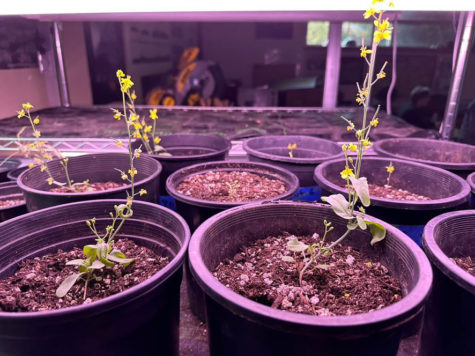Your donation will support the student journalists of West Linn High School. Your contribution will allow us to continue to produce quality content by purchasing equipment, software, and continuing to host our website on School Newspapers Online (SNO).
An inventive solution for dry farming
April 21, 2023
Dry farming may become the future and reality for many farmers. To come up with a possible solution, Alan Kolesnikov and Grace Sato, seniors, have been working on their ISEF project together for an estimated four months. Both Kolesnikov and Sato are students who have participated in ISEF before.
Kolesnikov and Sato simulated a farm where limited water would be available, attempting to find a solution to aid dry farming. Daikon radish was used as a cover crop that would store water during the winter, due to its high water content. As springtime rolled around, other normal crops were planted that would get watered by the daikon radish as it decomposed.

“The primary thing we focused on was proving the feasibility of the theory stated,” Sato said. “We watered plants and supported them through their entire life cycle with pretty much only a daikon radish root that was decomposing in the soil.”
Dry farming is a farming technique that produces crops without irrigation. Even in states like Oregon, that receive a large amount of rainfall annually, different factors can impact agriculture. In 2022, Klamath Falls suffered from extreme dry weather, resulting in federal officials shutting off water to farmers in the region for the remainder of the season. Dry farming can offer a secure solution for situations where water supplies are not steady.
“Our project is really important with the effects of climate change coming into focus right now,” Kolesnikov said. “We’re seeing areas that are getting less and less rain. And our specific idea is extremely important for those specific areas.”
However, this project was not a simple task, Kolesnikov and Sato encountered certain obstacles. In the first experiment, there were 50 plants, with only seven plants that sprouted. The process of taking precise measurements everytime the plants were watered took around two hours, only providing minimal information and data.
For the project, Kolesnikov created two websites along with a statistical modeling program that previewed the impacts of their experiment. The program applies the strategy the project used in actual agricultural situations. Specializing in another important aspect of the project, Sato took care of the experimented plants and focused on testing the theory.
“We come from two really different backgrounds of science,” Sato said. “[Kolesnikov] was the programmer and I’m the plant nerd. I think it’s really cool how we were able to combine those things and make one project that was really greater than the sum of our parts.”
Creating a sustainable option for agricultural areas that are impacted by harsh climate can have a role in forming a future without being reliant on irrigation. Preparing with new ideas and technologies, such as Kolesnikov and Sato’s daikon radish experiment, provides a different look to solutions.
“The idea that we produce in our project and present to people is a really novel way of looking at cover crops because nobody thinks to water a plant with another dead plant,” Sato said. “It opens up a perspective to more creative solutions for climate change, and I think that’s also really important alongside the direct impact it has.”